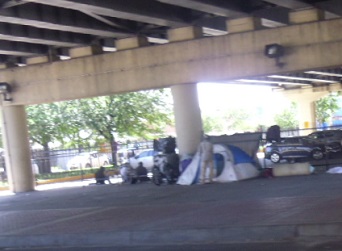Handling Homelessness, Both Occasional
and Chronic
Last Updated: January 5, 2025
Near the beginning of the pandemic, I noticed a marked upturn in homelessness in my own community. How about you? Economically marginal people working in vulnerable service industries, including hotels and restaurants, were suddenly visible on streets and in the park near my home. However, the pandemic is past now, and I still see unhoused women, households with children, and younger and older men who are in and out of homelessness in my own community.
Homelessness affects many women, an increasing number of children, and many veterans. On one night in January, 2024, the number counted in the U.S. was around 772,000 people, including some 80,000 families with children . This marked an 18% increase over the January, 2023 number, and set a new (bad) record. From 2022-2023, the increase was 12 percent, so you can see this problem is only escalating. The January one-night count was established a couple of decades ago; admittedly it is an imperfect count, but it is the best possible snapshot number that we have available. This annual count includes both people in shelters and those not in shelters.
 People may live under interstate bridges in your own community.
People may live under interstate bridges in your own community.As of 2020, about 70 percent of the unhoused were individuals, with the other 30 percent part of families, and about 70 percent of the individual adults without homes were male. However, that means that significant numbers of individual women and people in families were homeless.
The degree to which children, women, and younger people are represented in the homeless population is only increasing. While immigration and displaced immigrants mark part of the problem in the U.S., it is still concerning that a wealthy nation cannot house all of its residents.
Since we mentioned chronic homelessness in our headline, it's time that we fill you in on the more or less official definition of that term. About 30 percent of the unhoused population members are classified as chronically homeless, meaning that individuals have a disability and either they have been on the streets for a year or more, or they have been homeless at least 4 times in the last 3 years, for a total of a year of more.
While we will talk about this issue in terms of the U.S., we want to recognize the enormous refugee problem world-wide, where there are more refugees than at any time since World War II. Most European nations also have some degree of homelessness, although we would point to Vienna as a shining example of where temporary arrangements succeeded in getting people off the street into safer housing.
Focusing again on the U.S., it is not just a problem of the stereotypical chronically unemployed male. The root cause of homelessness is poverty, although each person and family has a unique story. Often people just suffer one or more financial setbacks that spiral out of control.
You may want to argue with me that the homelessness you see is all about alcoholism, drug use, and mental illness. Surely these are factors, but these things also lead to poverty, which is the whole point of this discussion.
If your neighborhood, rural, urban, or suburban, contains some homeless people, you should learn more about effective measures that avoid stigmatizing the individual, while helping each to become independent again.
You might think you do not have any homeless population, but you would be
surprised to find individuals and entire encampments along rivers and
streams, families living in their vehicles, veterans under bridges, and
groups or loners camped out in parks. Many homeless folks are staying with friends or relatives too, making them less visible.
In the U.S., the Department of Housing and Urban Development provides a number of programs for communities, and President Obama's goal was to end homelessness by 2015.
Obviously that did not happen. It seemed for a while that the problem was lessening, due in no small part to a "housing first" strategy in some communities, in my opinion. However, the combination of higher numbers overall and some high profile controversies about homeless encampments in a number of cities have led to some soul searching and pessimism among those of us who care about such things.
Specifically, in the case City of Grants Pass, Oregon v. Johnson, the U.S. Supreme Court held that the Grants Pass anti-camping ordinance did not constitute cruel and unusual punishment and thus was constitutional. This decision only adds to the urgency of figuring out how to help the unhoused in ways that both preserve their dignity and help neighborhoods and whole cities remain orderly.
At the neighborhood and community development level, you can't afford to ignore the problem, which presents a negative image for your community, symbolizes a collective failure as a society, and also represents lost potential for an individual who might contribute to your community in important ways if given a chance.
Dimensions and Causes of Homelessness
Three trends have converged to cause much of the current homelessness problem in the U.S.
First, rental housing, or at least affordable rental housing, is in relatively short supply in many places. There is often a long waiting list (think in terms of years, not weeks) for public housing units. The highest rates of homelessness tend to be in those states where affordable housing is scarce or where supply simply cannot keep up with the demand. A few cities with sky-high rents, such as San Francisco and New York, aggravate the problem.
Historically, single men especially who were living on the margin financially could find refuge in single-room occupancy (SRO) hotels or places such as YMCAs or YWCAs. Those resources have disappeared in most communities.
And in many cities the rental market is focused on young people who want luxury amenities, and older apartments that are torn down are not replaced with modestly priced housing.
In simplest terms, it's sometimes tough for people to put together enough money to break free from a cycle of homelessness. Consider our answer to a site visitor who wrote about a homeless person unable to save for permanent housing. It's really that simple.
Second, the poverty rate continues to be high, with 11.1% of the U.S. population estimated by the government to fall below the poverty line in 2023. While before the pandemic hit, poverty in most places had declined to about the rate before the 2008-2009 recession, that's still a lot of folks who don't have enough money.
Various estimates are that between 10% and 20% of the homeless population is employed, but minimum wage jobs don't pay for an apartment in many towns. A two-bedroom apartment for families isn't affordable on minimum wage jobs anywhere in the U.S. Many employed homeless have only part-time work, and others frequently lose jobs because of lack of job-related or social skills.
Causes of homelessness are as diverse as human fingerprints, and include all kinds of financial setbacks. In working with homeless people in my own community, I have found a couple of addicts, but several times as many people who have been caught up in a downward financial spiral caused by divorce. I have met some people who desperately want and need their own home again, while a couple of others have admitted they cannot really take care of themselves and need to be in some type of group home situation.
I personally know someone who prefers to remain unhoused due to a bad history of conflicts with landlords, probably bad landlords.
Any time someone wants to tell you all homeless people this or that, you can safely challenge their assumptions. Almost certainly any detailed survey in their own community would turn up a panoply of reasons and chains of events leading to lack of housing.
But researchers say that six types of issues stand out:
- Medical bills combined with lack of health insurance
- Mental illness, which lowers employment opportunity and compounds the inability to take intelligent action on one's own behalf
- Substance abuse leading to poverty, and then lack of ability to obtain effective treatment after becoming unhoused
- Domestic violence
- Poor readjustment to civilian life by veterans, especially those who were disabled permanently or temporarily by war injuries
- Simply lack of enough affordable housing in a location, aggravated by recent rapidly escalating rents.
Third, current programs simply are not sufficiently aggressive, especially in wake of the increase in homelessness near the beginning of the pandemic. Yes, municipal officials plod along working on tiny initiatives, or at least they are miniscule in terms of addressing the scope of the problem. We actually applaud California Gov. Gavin Newsom's refused to accept the proposals from California cities, which the Governor said would only reduce homelessness by 2 percent over a four-year period. Surely we can do better than that.
Why It's Serious: Housing Is Essential to Household and Neighborhood Stability
After working hard on low-income housing for several years, a friend once asked why I was so passionate about this issue. It all comes down to the fact that none of us function very successfully without a home base.
Think of the times in your life when you've moved from one residence to another. Were you your most alert, organized, well groomed, well behaved self during that week or two? Now magnify this by being homeless for five months or seven months, not uncommon experiences.
Not only is there no place to stow your stuff (the shopping cart with the garbage bag in it probably doesn't include a safe place for your resume and your diploma), but also you begin to face the new elements of fear for your safety, fear of negative confrontations with neighbors or law enforcement, and fear that your hiding place will be found out or occupied by others.
In some parts of the country, climate extremes compound the problem.
Some of you are thinking no one is homeless, because everyone can go to a shelter. That's not really so. In larger and colder cities, on some nights there aren't enough beds for the entire homeless population. In fact nationwide the estimate is that there are only 70 percent as many temporary beds in shelters as would be required for the entire homeless population, although in the past few years, the number of available shelter beds has actually increased, not decreased.
In major metro areas, shelters often limit the length of time one person can stay, and they often lock people out during the day. Shelters also may be infested with crime, lice, roaches, and bedbugs, not to mention of course loud and obnoxious drunks or mentally ill folk who sneaked in while acting normal.
The homeless also complain of weapons and various forms of intimidation, not to mention complete lack of privacy, in the shelters.
Like every human society, shelters have their own pecking order and their own informal norms of behavior, so people who can’t conform are left out (in the cold) again.
Lastly, of course health concerns made staying in shelters even less desirable during the worst points in the pandemic.
As a result of all these factors, there are going to be some homeless people in many neighborhoods. While we absolutely dispute the notion that homeless people are generally dangerous people, we do find that people living on the street doesn't portray an image that most of us would like for our neighborhoods. A neighborhood that is already teetering on the brink of decline needs to deal aggressively with any homeless problem that may exist.
Preventing Homelessness
Prevention is the best program. Below we discuss three essential elements of prevention.
1. Financial literacy should be taught in schools and to adults as needed. While states are busy trying to reform predatory lending, maybe they should require a good simple-to-read chart about financial issues to be distributed along with the payday loan!
It's amazing to watch the reality television shows about people who are deeply in debt and don't even know the extent of their shortfall each month. Often these are well-educated younger people, so imagine what happens with less educated folks who are deep in denial, addiction, or mental illness.
2. Community retention and provision of affordable housing must become a priority. A community has a moral obligation to fight to retain whatever affordable housing it has. Note that in housing markets where rents are increasing rapidly, affordability then becomes a moving target as well. In plain language, usually wage increases are not keeping up with housing cost increases in the strong market cities and regions.
While the federal government theoretically doesn't allow public housing units to be destroyed without replacement, that doesn't seem to be enforced in many cities and situations. We could give many specific examples, but in the interests of space, we won't.
Public housing can go vacant for months because its environment is so scary that no one wants to move in, or simply because the units haven't been repaired since the last people trashed the last place when they were evicted.
But beyond public housing as such, a community can look for opportunities when obsolete motel types go out of business, college dorms or student housing become vacant, and so forth. Community development dollars should go toward refurbishing these facilities into decent if modest housing allowing short-term leases if need be.
Neighborhoods and communities need to fight harder for affordable housing. Neighborhoods where there is any threat of gentrification need to be negotiating community benefits agreements requiring preservation, repair, or production of affordable housing before they throw support to a development proposal.
Yes, in many cities, more housing needs to be built. An aggressive increase in the number of housing units available will put downward pressure on rents. You could reasonably ask why more housing isn't being built, since rents are so high. Well, my answer is that the commentators who blame restrictive zoning and other regulations have a point in some situations. If you think that may be true in your community, please look into whether you can allow more rental housing to be built more easily. (See the entire zoning section of this website and also our page on YIMBY, which stands for "yes in my backyard" for more ideas. To say more will seriously sidetrack this page.)
Affordable housing can and should become a prominent part of the agenda of a neighborhood association when and where the supply does not keep up with the demand.
3. A region should provide good information about housing opportunities, and make that information easily understandable to social workers, faith groups, police, and others who may encounter or work with the homeless. Major cities need housing hotlines for those who are having difficulty finding housing.
If you're marginal in income, you may not have as much access as more prosperous folks to the internet, telephones, helpful co-workers, and transportation--the elements that middle-income people use to find housing.
Community groups can and should analyze government data and real estate data to detect housing trends at the neighborhood scale and begin to formulate proposals and programs to address issues
In small towns, or even at the county government level in more rural parts of the country, social service agencies need to go out of their way to be competent in keeping track of available reasonably priced housing.
A Simple, Pragmatic Way that Activists Can Help
This is so important that we decided to give this step its own headline so that you don't miss it. If you've read this far, you probably can implement this project on your own or with just a few like-minded people.
Understand that an extensive, friendly, and well-publicized network of solutions for people with mental health, substance abuse, social skills, and joblessness or underemployment issues is necessary. With cuts in social service funding everywhere, it's being left to the faith-based and non-profit sectors to take up the slack.
Many people suddenly faced with homelessness are ignorant of options outside of their old neighborhood and desperately need housing information. Sometimes they also need transit information about how to reach unfamiliar parts of their city.
Your community could print contact information about each of these issues on small laminated cards, which then can be handed out by service providers and community members likely to come in contact with homeless people and households.
Better yet, put this laminated card inside a small plastic bag containing a few granola bars, an extra pair of socks, and a few personal hygiene items, and have your little formal or informal group hand these out when they encounter an unhoused person.
If you are an activist not in a position to implement
any of our other, more systemic suggestions, at least you could
spearhead this project in your city.
Providing More Transitional Housing
Now we are moving the discussion back to more systemic ways to address the problem.
Before we launch into this, we need to make sure you understand that there are two schools of thought about the right course of public action in the face of homelessness. Some feel that permanent housing is the only correct solution and that anything else is simply putting a band-aid on the problem. Others believe that we need to get people off the streets as soon as possible, even if we are providing only temporary relief. This school of thought points to the worsening outcomes in terms of health, mental health, safety, and employability the longer a person lives homeless.
We tend to favor municipal programs that take a "both/and" approach. By all means, if you can move some homeless households into a conventional apartment or house, do so. For some individuals in some housing markets, all it takes to get that person back into housing is some good information about likely places and ways to look, maybe a little hand-holding and encouragement, and perhaps a phone call to a friendly landlord.
In other housing markets where there is a shortage of affordable housing units, being a friend to a homeless person means helping them look for a temporary or transitional situation. We need to consider that building more affordable housing is not something that occurs overnight.
Developers, social service agencies, and housing advocates must first locate suitable land (meaning that zoning allows construction, the "Not in My Back Yard" neighbors can be neutralized, and that the location is near transit, groceries, and pharmacies). Next organizations, nonprofits, or companies that want to build affordable housing must obtain all the necessary permits, sometimes fighting back legal challenges from outraged neighbors. Then often financing hurdles remain; usually affordable housing construction requires at least three sources of funding, but we have heard of as many of 30 different sources having to be coordinated! Assorted other mandates and requirements of the municipality or state may have to be met, including green building codes, flooding or wildfire prevention measures, and much more.
This is why sometimes you will hear professionals who deal with the unhoused concentrate on transitional housing. We want to talk about two types of housing that will be transitional for some but nearly permanent for those with the most severe situations.
Public housing Preservation and rapid turnaround of Vacant Units
While the federal government theoretically doesn't allow public housing units to be destroyed without replacement, that doesn't seem to be enforced in many cities.
Public housing can go vacant for months because its environment is so scary that no one wants to move in, or simply because the units haven't been repaired since the last people trashed the last place when they were evicted.
Inventive re-use of obsolete or vacant housing
Beyond public housing, a community can look for opportunities when obsolete motels go out of business, college dorms or student housing become vacant, and apartment complexes are no longer competitive.
Community development dollars should go toward refurbishing these facilities into decent if modest housing allowing short-term leases if need be.
Especially anything that still resembles an SRO downtown or on a prominent transit line should be rescued and rehabbed, concentrating on updating the electrical, heating, cooling, and ventilation systems.
Since the advent of microwaves and mini-fridges, a very livable single room can be devised. Make the rooms energy-efficient and well-repaired, allow occupants to choose their paint color, divide the smokers from the non-smokers without compromise, install any soundproofing possible, and provide good laundry facilities.
Most of all, an SRO needs what are called "supportive services." This means a social worker, or two or three, living on-site.
This is an ideal live-work situation for the social work graduate student or new grad. They can monitor for mental health needs, make sure people take their meds, make sure addictions and relapses are addressed, and teach life skills.
If the facility is large enough, a job coach could live on site as well. It might sound daunting, but it's do-able if a city has the will. Some people may never be able to advance beyond the SRO, but with support, they can live independently, stay off welfare, stay clean and sober, and support one another.
We should say that the SRO isn't the only possible architectural style that supportive housing could take. The point is to have something relatively inexpensive but large enough in scope that social, medical, or substance abuse workers could be regularly involved in the programming.
Ideally, a community also should provide an adequate number of well-run shelters with supportive daytime social service programs. The kids need to go to school (preferably continuing in the same school), and the preschoolers need enrichment while mom or dad is looking for a job, going to school, or getting their heads together.
There aren't many shelters that offer the comprehensive set of strategies that are needed to provide a base of temporary stability. Most shelters run on the principle of providing a bed at night and kicking people out in the morning.
Mental Illness and Addiction Related to Chronic Homelessness
This is short and to the point: As a society we can't afford to ignore mental illness and addiction any more. (And mental illness and addiction will make you poor, unless you are extremely high income, part of the 1%.) The social costs are just too great.
We have to treat these conditions aggressively, frequently, and for as long as necessary. One of the issues is that we've become focused on "brief therapy" as a way to control costs, but most addicts and severely mentally ill people need intensive therapy, followed by occasional therapy and a support system, whether that occurs through a 12-step group or a whole different system, for a long time.
Things are just upside down; teenagers and young adults are taking one or more anti-depressant medications when their life isn't perfect yet, while we're unwilling as a society to invest in adults who are deeply dysfunctional.
Refer to our community mental health page to offer some ideas on how the community can foster better identification of people having problems and offer more effective programs. The community poverty page is helpful also.
In terms of addiction, we could begin with a broader education of children and youth about life coping skills. We recommend starting or supporting a community anti-drug coalition with that emphasis. Then move on to the harder problem of adults. People need to be rewarded for starting to become self-aware enough to understand what drives them. And then they need straightforward and sufficiently rigorous rehab programs.
As a sidebar it's important to note that our policy as a society has been not to even try to heal addictions, unless people have money.
We lock people up if their dealing or using happens to end up right under our nose; otherwise we pretend it isn't happening.
Prison doesn't cure addictions; it incubates them. Let's quit the drug incarceration insanity and concentrate on treatment, teach coping skills, and set up ordinary life so it's not quite as stressful.
Systemic Solutions to End Homelessness
The current emphasis on what is called rapid re-housing is important and effective. A quick end to homelessness limits the damage to the psyche, work skills, and social skills, and especially to the children. The rapid re-housing approach includes identifying appropriate housing quickly, providing financial help for moving and rent payments, and social services after the move. This notion is beginning to fall out of vogue, we notice, presumably because it didn't bring an end to homelessness by 2015 as some were hoping it would.
We still think the idea has merit, which is why we are urging you to consider transitional approaches to re-housing if you cannot immediately provide enough affordable housing.
In the last decade the U.S. Department of Housing and Urban Development also emphasized an approach that it termed Continuum of Care, which calls on the entire community to commit itself to ending homelessness and to providing the broad spectrum of resources that will be useful to people trying to escape their short-term or chronic homelessness. This too is an idea that still has a great deal of merit.
Long-term, the solution for homelessness requires increasing housing supply in affordable price ranges, in addition to dealing with the domestic violence, mental health, substance abuse, and financial illiteracy issues.
The asset building approach, creating programs for the poor to save money for their future through individual development accounts (IDAs) or the equivalent, can be very important too.
We need to design more attractive affordable housing, learn sophisticated strategies for mixed-income-housing within our neighborhoods, and generally de-stigmatize accepting housing subsidies for a short time.
By the way, most us live in subsidized housing. I take my mortgage deduction on my income taxes; don’t you, if you live in the U.S.?
So get over your rant about subsidizing someone's housing. Housing is a basic human need, and your community has a moral responsibility to be inventive about helping to meet your share of that need.
For more information and helpful examples of what cities can do about homelessness, see this excellent homelessness and housing toolkit put together by the state of Washington. Some examples are specific to that state, but many are broadly applicable.
Read More Pages Related to Housing Solutions for the Unhoused

- Making and Keeping a Good Community >
- Housing Issues > Homelessness
Join GOOD COMMUNITY PLUS, which provides you monthly with short features or tips about timely topics for neighborhoods, towns and cities, community organizations, and rural or small town environments. Unsubscribe any time. Give it a try.



